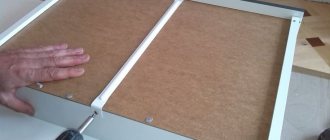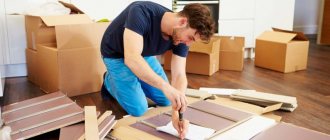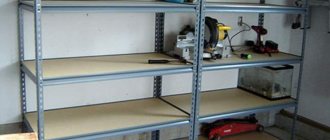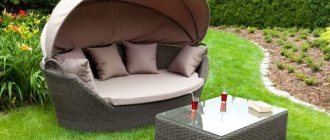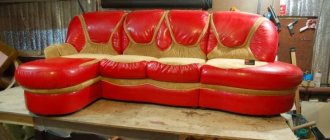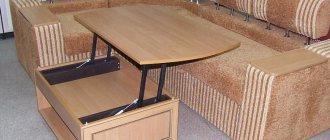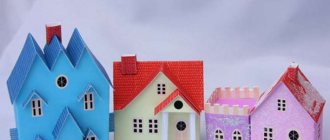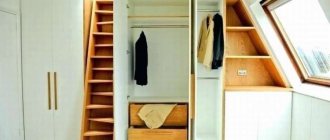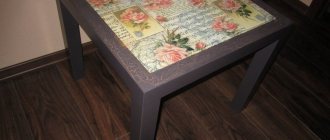Chipboard is one of the most common materials for making furniture. This is due to a number of advantages that it has, from low cost to versatility. The most important feature is the ease of working with the material. Even an inexperienced person can make furniture from chipboard with his own hands. However, before starting work, you should still carefully read all the rules and nuances; this will help to avoid problems during assembly.
Manufacturer's warranty
If you come to buy ready-made furniture, you need to check whether it is handicraft.
Each company puts a uniform hologram on its products - it guarantees the quality of the products. If necessary, you can always use it to check with the technicians of the technical control department, the team that carries out cutting and edging of the material, and packaging. In the event of a controversial situation or warranty case, this will help restore the entire production process; you just need to present a photo of the hologram.
A hologram is an insignia with a unique number that corresponds to a specific product
Another assessment is the manufacturer’s warranty. Trusted companies provide not only a certain service life of products, but also provide a guarantee on fittings. Durability is a direct indicator of the quality of furniture; the lower it is, the worse the quality of the materials used. In addition, many companies provide after-sales service for their models, which means that they are responsible to the consumer for the results of their work.
Average service life of furniture
What's better?
The cost of finished furniture products depends on what material is used for their production. Therefore, budget-class furniture uses inexpensive chipboard panels, which can be covered on only one side with a moisture-protective film. In addition, for the production of furniture, the factor that matters is whether the material from which it is made emits formaldehyde. For example, for a bed, a higher quality laminated chipboard material will be used, since its protective layer does not allow vapors of a harmful component to escape.
The cost of budget furniture made from chipboard is also affected by the type of material. There are several types of particle boards.
- Grade I - sawdust of a small standard fraction without any foreign inclusions is used as a raw material for the manufacture of panels. The finished chipboard is perfectly flat, smooth, and has no chips or cracks. The first grade of chipboard must be additionally decorated with film or veneer, and this is done on both sides of the chipboard.
- Grade II - made from high-quality sawdust raw materials of different fractions, a minimum percentage of foreign impurities is acceptable. The finished slab may have minor damage in the form of chips or scratches. For grade II chipboard, decorative cladding may not be used.
- Grade III - made from sawdust of various wood species, may include a small percentage of foreign inclusions. The material is not subjected to decorative cladding, since this grade is not used in furniture production. Grade III chipboard can be used only for construction purposes.
Based on the type of protective coating, particle boards are divided into the following main types:
- without cladding - such material is called rough; it is used only when performing construction work;
- laminated - chipboard has a durable varnish coating or treatment in the form of a melamine film;
- veneered - chipboard has an external finish with natural wood veneer.
Unlike chipboard, laminated chipboard materials have a wider variety. Lamination of the plate can be done in various color shades, as well as create an imitation of any texture. Furniture products made from laminated chipboard can be harmoniously integrated into almost any interior composition. They look good and elegant, and at the same time have a low, quite affordable cost. In some types of laminated chipboard material, a fire-resistant film containing carbon or HLP class material, which is resistant to fire, can be used as a laminating layer.
Laminated particle boards, despite many of their advantages, are prone to chipping and cracking. Most often this occurs from heavy objects falling onto the surface of the slab or under the influence of a mechanical factor. It is no longer possible to eliminate such a defect in furniture. Due to this property of the material, it is not subjected to various treatments by milling, so it is impossible to obtain a relief surface, smooth bevels or roundings from the laminated chipboard panel.
When a chip or crack appears, the surface of the laminated chipboard loses its safety, as formaldehyde begins to release outward, so the quality of the laminating layer and its stability play a very important role for this type of chipboard.
Chipboard material is not used for the manufacture of countertops or kitchen units, since only the laminated chipboard surface can withstand frequent and prolonged contact with water without compromising its appearance. Although prolonged wetness is undesirable even for laminated boards, such exposure from the edges of the material is especially dangerous.
To produce low-cost, but high-quality and beautiful furniture, modern manufacturers use both woodworking products - chipboard and laminated chipboard, and ordinary chipboard is used to create the load-bearing frame of the furniture, while the facade part is made using laminated board. Furniture products made from a combination of materials can be used both for home use and in office spaces.
See the following video about the differences between materials.
Manufacturing stages
At first, it is not always clear to a beginner what to tackle first. You can find a simple master class in open sources, but in many videos and instructions they rarely pay attention to dividing the work into stages. But a detailed description is very important, as it helps to do everything consistently, quickly, and at the same time with high quality.
How to make a doll closet yourself, tips for beginners
Drawing
A prerequisite for starting work is to find or complete a furniture drawing. It is compiled manually or using special programs on a computer. You can also find ready-made drawings in forums for craftsmen. You need to have at least the slightest skills in reading diagrams if they are taken from a third-party source. Drawings are not always correct; they need to be checked. If you don’t have such a skill, then you should consult with a knowledgeable person.
Detailing
This is called drawing up a diagram of individual parts of a product. This approach will allow you to divide the assembly process into stages. Also, from a solid drawing it is not always possible to determine the exact dimensions of the constituent elements. Having initially spent more time at this stage, it will then be much easier to assemble the furniture and make individual parts for it.
Cutting, processing of slices
When you have an idea in your head of what needs to be done, and how to get it is reflected on paper, cutting the material into sheets of the required size begins. It’s worth making as many of them as you need at once, and cutting out individual elements from each piece. It will work faster and easier this way.
After cutting, it is necessary to process the cuts. Even the best quality tool will leave nicks in the material. Sandpaper or felt cloth is used for processing.
Drilling holes for fasteners
Already on the finished parts, using a drill and a drill or a screwdriver, all the holes are made. This stage should not be taken lightly. Chipboards are very sensitive to such procedures, so you need to be careful. It is necessary to know the exact diameter of the holes in advance. You will not be able to change them in the future.
Assembly
Only after all the stages comes the furniture assembly itself. There is nothing complicated here anymore if the master thought through the drawings in advance and chose the right fasteners. The only thing you need to be careful with is the sensitivity of the material to drilling, screwing and any deformation. Too much force may strip the threads. It will not be possible to re-screw the screw into this hole; you will have to make a new one.
Finishing
The final stage is finishing and decoration. The varnish coating is responsible for how long the furniture will last. A good product will protect against deformation and moisture. You can also use a special film instead. If you plan to paint furniture, then it is done before applying a protective layer and with preliminary treatment - sanding, cleaning, leveling the surface. There is no need to think about how veneer cladding is done at home. This is a complex procedure that can only be performed in a factory.
What is modern furniture made of, an overview of the main materials
What is the difference and what is common between OSB and chipboard
First, some definitions.
Chipboard is a chipboard made by pressing from wood chips of arbitrary shape.
OSB is a wood board, for the production of which specially shaped shavings are used, which are oriented in certain directions before forming the boards. The plate consists of three layers. In the outer layers, the chips are oriented in one direction in the plane of the slab, and in the middle layer - perpendicular to the outer layers in the same plane.
The name OSB is obtained by transliteration of the English name - Oriented Strand wood construction Boards (OSB). Along with them, the Russian-language term and the corresponding abbreviation are used - Oriented Strand Board (OSP).
Both materials compared are composites based on wood waste. They are manufactured in the form of sheets or slabs of different thicknesses and sizes. In both cases, the boards are formed from wood chips using formaldehyde resins. This is where the main similarities between them end.
The main difference between OSB and chipboard can be seen from the above definition. This is a special shape and orientation of the chips.
Range of materials
Chipboard is produced with a thickness of 1 mm and above, in increments of 1 mm. The most commonly used plates are 10, 16 and 18 mm thick. These are furniture standards. The most popular sheet formats are 2750x1830, 1830x2440, 2800x2070 mm. But there are a lot of options, starting from 1800 in length and 1200 in width.
OSB has a thickness from 6 to 40 mm in 1 mm increments. The most commonly used formats are 2500x1250 and 2400x1220 mm, although there can be a variety of options. The minimum size defined by the standard is 1200 mm. In addition to ordinary rectangular sheets with a smooth edge, tongue-and-groove slabs are produced, which are convenient to use as cladding. When they are joined, the profiled edges form a lock that aligns adjacent panels into one plane.
According to their physical and technical parameters, each material is divided into grades or types.
Chipboard:
- type P1 – for general use;
- type P2 – for dry indoor conditions, including for furniture manufacturing.
OSB:
- OSB-1 – boards for unloaded elements used in dry conditions;
- OSB-2 – boards for load-bearing parts, for dry conditions;
- OSB-3 – boards for loaded products in wet conditions;
- OSB-4 – for wet conditions under increased loads.
Safety
The production technology of board materials implies that MDF contains less harmful substances than chipboard. We are talking about volatile substances released by resins (used as binders), harmful to humans, which gradually (during long-term operation) “evaporate” and accumulate in the air if there is no sufficient ventilation of the room. All these substances do not cause immediate damage to the human body and have a harmful effect only with prolonged contact with them (in other words, if you decide to lie on a chipboard or MDF board for a long time, you will die not from poisoning with the substances they secrete, but from thirst, hunger or from old age).
However, manufacturers still established a certain gradation:
- MDF - with strict adherence to technology and high-quality cladding of surfaces, structures made from it are considered the least dangerous in terms of the release of harmful substances into the surrounding air. In the production of MDF, the main binder is lignin, released during the heating of wood. Therefore, high-quality MDF is environmentally friendly;
— E1 class chipboard – ranks second in terms of safety for the human body (but also only with appropriate surface cladding);
— Class E2 chipboard – emits the largest amount of harmful substances, is prohibited for production in foreign countries, and in Russia it is prohibited for the production of furniture and products used inside public and residential premises (GOST 10632-2007).
The difficulty of determining the harm actually caused by these materials is that the information recorded in the certificates is not always true (and sometimes the certificates attached to the materials are not “original” ones, that is, compiled based on the results of tests, but “purchased ones”). In addition, not all manufacturers (especially Russian ones) follow the recommended process technology for the production of MDF and chipboard, trying to save money by using lower quality resins.
Required Tools
You won’t be able to assemble anything without tools, so you need to take care of them in advance. To make work easier, you should choose high-quality devices. If possible, you can make do with what you have available. During assembly you will need:
- Drill or screwdriver. They are needed to make connecting holes with which the master will assemble the furniture.
- Circular saw, jigsaw. With their help, sheets of the required size will be cut.
- Measuring instruments (ruler, level, corner, tape measure). They will help you avoid making mistakes with the dimensions of the parts.
- Hexagons and screwdrivers. The specific set depends on what fittings are selected.
- A drill, or better yet several. They will make holes of the required diameter.
A screwdriver is best, because a drill is too bulky and inconvenient. Its power will be excessive for assembling furniture at home. The circular saw must be of high quality, otherwise there will be many irregularities left, and in the worst case, the slab may be damaged. The jigsaw is used both electric and manual. A set of several drills is also useful, since different fittings require holes of different diameters.
Solid wood or chipboard? Pros and cons of materials
Solid wood, chipboard, MDF, fiberboard - what do these terms mean, and how can an unenlightened buyer not get confused by them? What is the furniture around us made of - wardrobes, chests of drawers, cabinets, furniture for the kitchen, bathroom and bedroom?
Solid wood
Furniture made of solid wood gives solidity and a noble appearance to the room. Often, this is exclusive furniture made to order.
+
naturalness and environmental friendliness of the material;
—
natural wood is prone to darkening and is sensitive to dampness and temperature changes;
—
expensive and not always available option.
A cheaper analogue is furniture made from wood boards. MDF, chipboard, laminated chipboard, fiberboard are materials based on wood, but in the form of shavings, fibers and sawdust. Most often this is wood processing waste, as well as raw materials obtained during sanitary cutting of trees.
The classic option for furniture production is: the front part is made of MDF, the body is made of laminated chipboard, the back wall is made of fiberboard.
Medium Density Fiberboard
(from the English. Medium Density Fiberboard - MDF -
MDF
). In the production of MDF, the raw materials are ground practically into dust and mixed with organic or non-toxic resins. It is a material that is easy to process, which is very valuable in the manufacture of furniture that requires grace and fine lines.
+
the density of the board, which almost matches the density of natural wood, holds screws and other fasteners well;
+
ability to produce bent furniture elements
+
The stove is immune to microorganisms, mold and fungi.
—
reacts painfully to temperatures above 70 degrees Celsius: it swells, warps, and the decorative coating bubbles and peels off, which is why MDF furniture is not recommended to be placed near heating devices;
—
furniture made entirely from MDF is quite expensive, so such boards are most often used only in the production of facades.
Chipboard and laminated chipboard
Chipboard
(the official abbreviation is
DSTP
, colloquially chipboard) is made by hot pressing large chips mixed with a binder - synthetic resin.
Chipboard was produced back in the 1930s by the German inventor Max Himmelheber, and in 1951 he received a patent for his invention. “Ideal wood” - that’s what chipboard was called back then for its homogeneous structure and the absence of defects inherent in wood (knots and cracks).
The most common material for the production of cabinet furniture is laminated particle board
- or
LDStP
, colloquially LDSP. This is chipboard, onto which decor is glued on both sides, imitating the texture of various types of wood.
+
products made from laminated chipboard are resistant to moisture due to the laminating coating, in contrast to the solid wood counterpart described above. Furniture products made from laminated chipboard are as convenient as possible during operation: they can be easily cleaned and washed with usual detergents. Although, of course, it is better to avoid abrasive preparations, they can ruin the surface;
+
low price with a large number of color solutions;
—
the material is not suitable for creating bent furniture elements;
—
The main negative characteristic of particle boards is the presence of formaldehyde resins, which, in high concentrations, have a negative effect on human health. That is why it is necessary to ensure that the finished product contains as few uncoated areas of chipboard as possible.
Since 1986, an international scale has been in force that determines the emission class of wood-tile materials. It regulates the content of free formaldehyde in the products of manufacturing companies. The following international classification has been adopted: formaldehyde-free board of emission class E0.5 is used in the production of special furniture, for example, medical and children's furniture. Furniture made from chipboard with emission class E1 is approved by all Western countries, Ukraine and Russia for use in residential premises
. Chipboard with emission class E2 is prohibited for use in residential premises by the ministries of health of all European countries. EZ - wood boards suitable only for use in construction.
Fiberboard and fiberboard
Fiberboard
or
fiberboard,
in common parlance - hardboard. The composition is similar to MDF, but is less dense and thick, and does not have a decorative finish. The use of such a board in the production of furniture makes the product more affordable.
Treated fiberboard
or
DVPO.
A slab, one side of which is painted in a single color or imitates wood. The scope of application of such a plate in the manufacture of furniture is limited: the back walls of cabinets, the bottoms of drawers and other parts that do not involve a large load.
What do salt and chipboard have in common?
What happens if you combine two poisons to form a new substance? Correct: a new substance with unique properties. A clear confirmation of this is kitchen table salt, ordinary sodium chloride.
Chlorine is a toxic asphyxiating gas. Pure sodium is flammable, and as a result of its violent reaction with water, a caustic alkali is formed. But the combination of these two substances - sodium chloride - plays an important role in human life. So important that people on average consume up to five kilograms of salt per year. At the same time, no one even thinks of comparing it with chlorine or sodium - the properties are not the same.
Now let's return to formaldehyde resins. This is also a completely new substance, which is produced from toxic, flammable and carcinogenic phenol and formaldehyde. Properly cured resin is an absolutely harmless substance. The only danger is the unreacted formaldehyde residues.
It should be borne in mind that most of this carcinogen evaporates during the production of plates that undergo high-temperature treatment. Then these products undergo certification, as a result of which the emission class (emission amount) of formaldehyde is determined.
Well, the final stage of processing furniture chipboard and MDF is lamination - coating with melamine film or special varnishes, which almost completely eliminate the interaction of the board with the environment. That is, even those formaldehyde residues that are allowed by the standards are sealed inside the slab and practically do not evaporate into the atmosphere (with the exception of the open ends of the furniture). But what happens if the coating is damaged?
Which is better to choose?
Among furniture manufacturers, laminated chipboard and MDF are in almost equal demand. However, when choosing products from a particular material, you need to take into account the upcoming operating conditions (expected power loads, humidity, temperature effects).
For kitchen
Modern kitchen units can be made from particle boards or fibreboards. Furniture made from laminated chipboard is considered to be of poor quality. Under the influence of humidity, it will quickly lose its visual appeal. Kitchens made from fine particles are more reliable, durable and durable, but they will be too expensive.
To make the set cheaper, it is recommended to purchase a combined product. It is best if the facades, sink cabinets and sliding doors are made of MDF.
For the bathroom
MDF and laminated chipboard are wood-based boards from which budget furniture is made. For this reason, they are often used in the production of bathroom products. However, neither MDF nor laminated chipboard panels are suitable for use in the bathroom. The conditions in this room are too difficult - excessive humidity, temperature changes, regular exposure to water. Even a moisture-resistant fine-grained slab under such conditions may soon lose its impeccable appearance.
If there is no other choice, experts recommend choosing MDF furniture. At the same time, preference should be given to high-quality products with processed edges and ends. Products with thin melamine tape are not suitable for the bathroom - during use, cracks easily form on it, through which moisture penetrates. Getting under the protective film, it leads to deformation of the furniture.
Conscientious manufacturers in the production of high-quality furniture use a thick and durable PVC shell that is difficult to damage
If your budget is limited, you can take a closer look at models made from chipboard, but in this case you need to pay attention to the labeling. Bathroom products should be made from chipboard with increased moisture resistance
Such materials are marked “B”. They are made using paraffin.
For children's
When arranging a children's room, it is best to choose furniture made from safe MDF material. Dressers, cabinets, shelves, desks, beds or sofas are made from it. Due to the evaporation of formaldehydes, furniture made from laminated chipboard can cause allergies, dizziness and other health problems in a child. It is not recommended to purchase furniture made from particle boards for children under 7 years of age.
For the bedroom
A person spends a lot of time in this room resting at night, so when choosing furniture, you should first of all take into account its safety for health. MDF products are more environmentally friendly, which is why they are preferable. However, to save budget, many people prefer laminated chipboard furniture. In this case, you need to look at the quality certificate of the slabs. They can have 2 classes - E1 and E2.
Furniture with class E1 is considered safer due to lower formaldehyde content.
For the living room and hallway
In these rooms, wardrobes, tables, slides and lounge furniture made of MDF or laminated chipboard are often installed. If there is no need to save money, you can furnish the corridor and living room with furniture made from MDF panels.
Step by step instructions
Even knowing all the nuances, it is difficult to do something without instructions that spell out each action. It is especially difficult to make interior items for the first time. Below are descriptions of assembling the three main types of chipboard furniture.
Closet
This is a classic piece of furniture. You can put anything in it, and it is very easy to assemble. Essentially, we do everything described above. First you need to draw up a drawing and cut out the material. The most optimal dimensions would be 350–450 mm in depth, about 800 mm in width and 2000 mm in height. This cabinet will fit in most rooms, but you can choose your own sizes.
The assembly process itself consists of 7 stages:
- Laying out parts on a flat surface for high-quality assembly.
- Connecting the top of the cabinet with the side walls.
- Fastening the remaining elements.
- Assembly of the lower part.
- Installation of internal shelves.
- Fastening the rear wall and doors, if any.
- Installation of furniture legs.
The cabinet parts must be connected using an angle.
Cabinet
The optimal dimensions of the cabinet will be 600 x 400 x 1850 mm. Here you can place a TV or use it as a coffee table. After choosing the sizes, assembly begins:
- Manufacturing a rectangular structure from 4 main parts for the frame.
- Placing marks for shelves, drilling holes for their fastening.
- Assembling drawers, if any.
- Installation of accessories.
- Attaching handles.
- Door installation.
- Attaching the top panel.
Next, you can decorate the cabinet to your liking and start filling it with household items and things. If the furniture is intended for a child, it is important to take into account his wishes or decorate together. Perhaps in a few years the chipboard cabinet will have to be restored due to intensive use, but this should not be a problem. Thanks to modern means, you can disguise chips, cracks, restore the color of a faded surface, and so on.
Table
Making a table is even easier than making a cabinet or cabinet. This is possible provided that a simple rectangular design of the written version has been chosen. Master class on making furniture:
- Holes are drilled in the prepared central and side walls. Next, these parts will be connected to each other.
- The upper shelves are attached.
- Additional partitions are made for installing boxes.
- The boxes are assembled and the selected guides are attached to them.
- The guides are installed at the locations of the baskets.
- The drawers are installed in guides.
Making furniture from chipboard with your own hands is not as complicated a process as it might seem at first. Selecting the right material, creating a drawing and a responsible approach will help you get a decent product the first time. Beginning craftsmen should choose simpler and clearer instructions for making furniture and be more careful when working with chipboard.
How to choose the right chipboard?
Today there are a considerable number of chipboards for various purposes. Their differences lie in thickness, composition, wear resistance, and density. Such features are associated with use in different areas of plate production. There is a stereotype about the density of the slab. It is believed that the denser it is, the better. But it is not so. The advantage of these boards is the low-cost raw materials (low-grade wood). This includes “thin gauges”, slabs, slats. The main thing is that these materials meet the following standards.
- Chip fractions should not be small.
- The cross-section of the chips should be square and petal-shaped. If these requirements are violated, the physical and chemical properties of the finished slab will deteriorate (bending and resistance will suffer).
Laminated chipboard has a wide range of colors, which is widely used in the production of cabinet furniture.
Consumers often ask questions: what kind of material is this for a bed - MDF? What is the difference between MDF and laminated chipboard for furniture? Let's consider these nuances in more detail.
The film is paper impregnated with melamine resins, which is why you can often find the term “melamine board”.
- low price;
- does not dry out, does not flake, does not mold;
- thanks to chemical additives, bugs do not live in the stove;
- service life more than 10 years.
- reasonable price for consumers with average incomes;
- strength;
- moisture resistance;
- includes all of the above advantages of chipboard.
Laminated chipboard can be washed and cleaned - it is moisture resistant.
The choice of material depends on what you plan to make. Laminated chipboard can be used in the manufacture of furniture intended for offices, homes, shops, and supermarkets. MDF is better to choose for children's furniture.
He is also not afraid of high temperatures.
The production of fibreboards allows us to produce products at affordable prices for various interiors. Thanks to MDF and laminated chipboard furniture, every home will be filled with coziness, warmth and comfort.
Its advantage, in addition to all of the above, is its excellent ability to imitate various textures, most often imitation of wood texture.
Pay attention to formaldehyde content standards in cabinet furniture
How to improve raw chipboard ends
After cutting a beautiful laminated material, end cuts remain that do not have a very aesthetic appearance. In factory conditions they are glued on industrial machines, and in everyday life special melamine edges are used.
The material for finishing the end sections is a thin strip of paper impregnated with melamine resins. It must be glued to the edge of the chipboard by heating and pressing with an iron. The quality of the resulting “home lamination” is not high, but it protects the material from crumbling and improves its appearance.
Do-it-yourself computer desk made from chipboard scraps:
MDF and laminated chipboard: what is the difference
The composition of particle board (chipboard) includes compressed shavings and sawdust impregnated with formaldehyde resins. Depending on the grade, chipboard has different quality characteristics: from a loose material with a density of 300 kg/m3 to a more durable and expensive one with a density of 600 kg/m3, which is precisely used in the manufacture of furniture.
Modern production makes it possible to minimize the harmful effects of the binder resin and improve the appearance of the slab by coating it with melamine film - lamination. Hence the name “chipboard”. The film has good aesthetic properties and does not allow formaldehyde to evaporate.
The production of MDF boards takes place using improved chipboard production technology - by drying wood fiber and hot pressing. Medium Density Fiberboard (MDF) contains only the finest sawdust, compressed to a homogeneous state. Unlike chipboard, which must be thoroughly sanded before covering with film,
MDF immediately has a smooth and even surface. This board is denser and more durable, resistant to drilling and moisture compared to laminated chipboard. It is also better suited for deep milling and deformation when creating radius furniture facades. In addition, MDF board has significantly higher environmental properties due to the fact that mainly natural resins, lignin and paraffin are used as sawdust impregnation. Formaldehyde is also present, but in much smaller quantities.
To make the differences between the two materials more clear, you can compare the structure of chipboard with a heterogeneous raw material passed through a blender, and MDF with a product from a meat grinder. The density of MDF board varies from 600 to 800 kg/m3, which in conditions of high moisture allows the material to surpass even natural wood in some characteristics.
Caring for laminated chipboard or MDF furniture
There are several general conditions for caring for furniture made from MDF or laminated chipboard.
- Prolonged exposure to high temperatures is undesirable: at 75 degrees and above, peeling of the coating is possible.
- Another factor is sunlight, which can also change the appearance of the slab. Film on laminated chipboard is more susceptible to fading, although MDF may change color somewhat with constant exposure to sunlight.
- You also need to be careful about long-term interaction with water. If the joints of the coating are not sealed, when water gets inside the slab, the sawdust will swell, and the slab itself will lose its appearance and properties. However, this is an extreme case. Under normal household conditions, with short-term exposure to water, which is inevitable in the kitchen, the stove can retain its original appearance for a long time. MDF manufacturers claim that fiberboard can withstand even a small flood.
Chipboard or MDF: which is better?
The common advantage of both materials compared to natural wood is resistance to pests and fungal infection.
Advantages and disadvantages of MDF:
Chipboard and MDF: combining materials
The best option for your wallet, without sacrificing quality and durability, is to choose furniture with a combination of materials.
Laminated chipboard will perfectly fulfill its functions as the basis for the kitchen body, and MDF, thanks to the variety of films for coating and the possibility of decoration, will allow you to make beautiful facades that will fit perfectly into the interior of the kitchen. So you shouldn’t choose what’s better for the kitchen: MDF or chipboard? The answer lies in the correct combination of both materials and their rational purpose.
For example, laminated chipboard, in addition to being used in furniture, can be used as an inexpensive, but durable and reliable tabletop of various thicknesses: from 25 to 38 mm. The plate is covered with multilayer plastic using Postforming technology. This slab is resistant to moisture and mechanical damage, so it will last for many years without requiring special care.
High-quality laminated chipboard in combination with MDF can also be used in the production of other furniture, including wardrobes, beds, and furniture groups for a children's room. If the joints and connections of laminated chipboard are reliably protected, and the manufacturer has appropriate certificates confirming the environmental friendliness of the material, then such furniture is safe to use and can deservedly take its place in the apartment.
Design of cabinet furniture and selection of materials
To quickly develop projects for furniture products, special computer programs are used. Today it is not difficult to choose the right software for making furniture, since the market for these software products is extremely large. Many programs are available in a free version, which allows you to save money at least at the initial stage. Some of them allow you not only to develop drawings and visualize them in volumetric form, but also to calculate project estimates for different materials.
At the design stage, the appearance and functional elements of the furniture are determined, the overall dimensions of the product and the materials from which it will be made are selected. Based on the project, fittings and fasteners, decor and inserts, and other details are selected. Drawings of product elements for cutting are made, and an assembly flow chart is drawn up.
Solid wood or chipboard? Pros and cons of materials
Solid wood, chipboard, MDF, fiberboard - what do these terms mean, and how can an unenlightened buyer not get confused by them? What is the furniture around us made of - wardrobes, chests of drawers, cabinets, furniture for the kitchen, bathroom and bedroom?
Solid wood
Furniture made of solid wood gives solidity and a noble appearance to the room. Often, this is exclusive furniture made to order.
+
naturalness and environmental friendliness of the material;
—
natural wood is prone to darkening and is sensitive to dampness and temperature changes;
—
expensive and not always available option.
A cheaper analogue is furniture made from wood boards. MDF, chipboard, laminated chipboard, fiberboard are materials based on wood, but in the form of shavings, fibers and sawdust. Most often this is wood processing waste, as well as raw materials obtained during sanitary cutting of trees.
The classic option for furniture production is: the front part is made of MDF, the body is made of laminated chipboard, the back wall is made of fiberboard.
Medium Density Fiberboard
(from the English. Medium Density Fiberboard - MDF -
MDF
). In the production of MDF, the raw materials are ground practically into dust and mixed with organic or non-toxic resins. It is a material that is easy to process, which is very valuable in the manufacture of furniture that requires grace and fine lines.
+
the density of the board, which almost matches the density of natural wood, holds screws and other fasteners well;
+
ability to produce bent furniture elements
+
The stove is immune to microorganisms, mold and fungi.
—
reacts painfully to temperatures above 70 degrees Celsius: it swells, warps, and the decorative coating bubbles and peels off, which is why MDF furniture is not recommended to be placed near heating devices;
—
furniture made entirely from MDF is quite expensive, so such boards are most often used only in the production of facades.
Chipboard and laminated chipboard
Chipboard
(the official abbreviation is
DSTP
, colloquially chipboard) is made by hot pressing large chips mixed with a binder - synthetic resin.
Chipboard was produced back in the 1930s by the German inventor Max Himmelheber, and in 1951 he received a patent for his invention. “Ideal wood” - that’s what chipboard was called back then for its homogeneous structure and the absence of defects inherent in wood (knots and cracks).
The most common material for the production of cabinet furniture is laminated particle board
- or
LDStP
, colloquially LDSP. This is chipboard, onto which decor is glued on both sides, imitating the texture of various types of wood.
+
products made from laminated chipboard are resistant to moisture due to the laminating coating, in contrast to the solid wood counterpart described above. Furniture products made from laminated chipboard are as convenient as possible during operation: they can be easily cleaned and washed with usual detergents. Although, of course, it is better to avoid abrasive preparations, they can ruin the surface;
+
low price with a large number of color solutions;
—
the material is not suitable for creating bent furniture elements;
—
The main negative characteristic of particle boards is the presence of formaldehyde resins, which, in high concentrations, have a negative effect on human health. That is why it is necessary to ensure that the finished product contains as few uncoated areas of chipboard as possible.
Since 1986, an international scale has been in force that determines the emission class of wood-tile materials. It regulates the content of free formaldehyde in the products of manufacturing companies. The following international classification has been adopted: formaldehyde-free board of emission class E0.5 is used in the production of special furniture, for example, medical and children's furniture. Furniture made from chipboard with emission class E1 is approved by all Western countries, Ukraine and Russia for use in residential premises
. Chipboard with emission class E2 is prohibited for use in residential premises by the ministries of health of all European countries. EZ - wood boards suitable only for use in construction.
Fiberboard and fiberboard
Fiberboard
or
fiberboard,
in common parlance - hardboard. The composition is similar to MDF, but is less dense and thick, and does not have a decorative finish. The use of such a board in the production of furniture makes the product more affordable.
Treated fiberboard
or
DVPO.
A slab, one side of which is painted in a single color or imitates wood. The scope of application of such a plate in the manufacture of furniture is limited: the back walls of cabinets, the bottoms of drawers and other parts that do not involve a large load.
